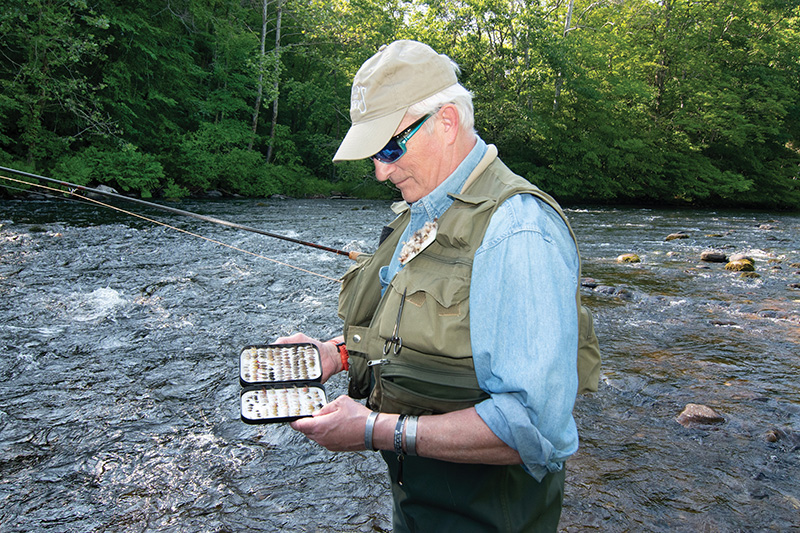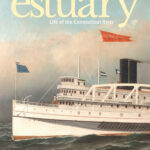 This article appears in the Summer 2024 issue
This article appears in the Summer 2024 issue
 The Farmington River
The Farmington River
Story and Photos by Ed Mitchell
Fly anglers are dyed-in-the-wool optimists, forever believing the next cast or the next bend in the river holds the fish of a lifetime. It is a creed we live by, and in no place does it spring more eternal than on a blue-ribbon trout stream such as Connecticut’s Farmington River.
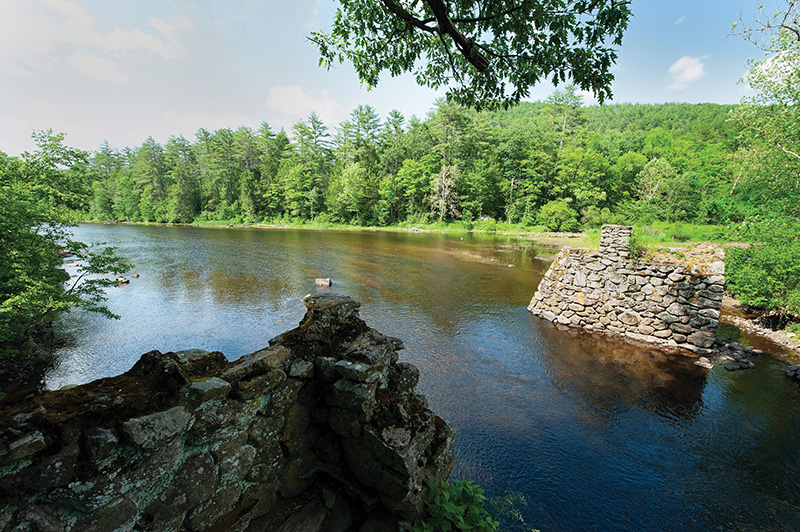
Start of the year-round trout management area, Farmington River, Whittemore Recreation Area, Barkhamsted, CT.
Winding forty-six miles from the northwest corner of the state, the Farmington River joins the Connecticut River in Windsor, Connecticut. The upper fourteen miles were designated Wild & Scenic twenty years ago and are fed from the Goodwin Dam’s bottom release on the Hogback Reservoir in Riverton—supplying cool water for happy trout all season long. The river is wisely managed. Amply stocked, it grows large with numerous holdover fish, and supports natural reproduction as well. Add in good public access and a picturesque countryside, and you know why the Farmington is considered one of the finest trout fishing destinations on the entire east coast.
There are three trout management areas (TMAs) on the upper Farmington River. Here, I’ll focus on the fabulous dry fly-fishing found in what is called the “year-round” TMA. Fear not, in the fall issue, I’ll cover more water. The “year-round” TMA begins at the tail end of a long pool in the Whittemore Recreation Area in Barkhamsted. Two old footbridge abutments mark the exact spot. From there the TMA runs downstream for several miles to the Route 219 bridge in New Hartford. This entire stretch is ‘‘catch & release” and “barbless hook” only, all season long. Trout from sixteen to eighteen inches are common, and trout twenty inches and well beyond are regularly landed. Not surprisingly, trout of this size have anglers driving hundreds of miles to fish here.
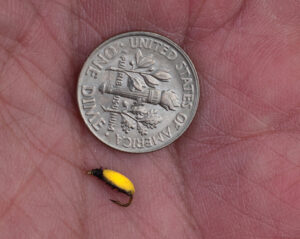
Winter Caddis Dry Fly.
December / January / February
It is entirely possible to take a trout on a dry fly even in the dead of winter. If the roads are clear of snow, you can start in December with blue-winged olives (BWOs). They are tiny, however, size 22 and smaller, so dig out your reading glasses and your 7x tippet. By February the action opens a bit with winter caddis and early stoneflies. A foam-backed, floating pupa in sizes 18 and 20 is used to mimic the winter caddis. The Church Pool below the Route 318 bridge in Pleasant Valley is a hot spot for this hatch. Stop and watch the expert anglers at work; one can learn a lot. By the middle of the month, early black and brown stoneflies appear in the afternoons. They vary quite a bit in size, so carry a selection from 14 down to 18.
March / April / May
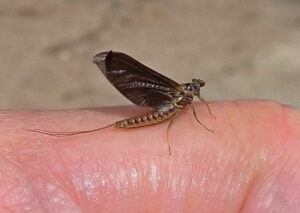
Hendrickson Mayfly.
The early stoneflies linger into March, but you had best be getting ready for the first major hatch of the year—of the Hendrickson (Ephemerella subvaria). Depending on weather conditions these big mayflies arrive from early- to mid-April, bringing up large trout. Matching dry flies in sizes 12 and 14 is the ticket. Note you may also see a similar mayfly in size 16 mixed in—Paraleptophlebia adoptive. Expect action to start in the warmest part of the day. Hendricksons typically emerge in riffles where the trout will be very aggressive. These mayflies then float down into the neighboring pool, requiring a bit more finesse. Spinner falls are late in the day. Dead drifting a red-brown spinner dry fly is the key. In fact, red-brown spinners are a great anytime dry fly. The Farmington doesn’t have a strong population of March Brown (Stenonema vicarium). But you should consider carrying a match regardless. As May warms expect tan caddis (Hyropsyche) and green caddis (Rhyacophila) in sizes 14 to 18. They will be around until fall. And as always on this river, BWOs may pop up without warning.
June/ July / August
Next is perhaps the finest hatch of the year—the Sulphurs (Ephemerella invaria; Ephemerella Dorothea). Kicking off in late May, it can last quite a while. Matching dry flies in sizes 16 or 18 should be in your box. Some Sulphurs can show up in early afternoon, but the fishing to them is difficult. Wait until late afternoon down to dark, since this is when the hatch can be an absolute blizzard. Spinner falls also occur on the edge of darkness.
At roughly this same time, Light Cahills (Stenonema Ithaca) enter the scene too, lasting into July. Like the Sulphurs, typically Cahills wait for low light, although a cloudy day may bring them off earlier. A cream-colored dry fly in sizes 12 to 16 does the magic. And that fly may do double duty, as a Cahill look-alike mayfly might show. Sometimes called a Yellow Quill or Pale Evening Dun, Epeorus vitreus typically favor fast water.
With water temperatures hitting their highest, the dog days of summer bring the diminutive Tricos (Tricorythodes stygiatus). Expect this hatch in the early mornings near the middle of August, carrying into early September. It requires tiny dry flies in sizes 22–28. So once again dig out your reading glasses and 7x tippet. Given the volume of bugs on the water this can be tough fishing. Spinner falls are usually the more productive.
Summertime is also prime for fishing terrestrial dries—ants, beetles, crickets, and hoppers. The river has few grassy banks, so hoppers are not common, but a hopper dry fly is always worth trying, particularly on breezy mornings. My favorite terrestrial fly is a red ant in 18. It fools even the spookiest trout. But don’t ignore large terrestrial flies. The ungainly looking Chernobyl foam ant is an absolute killer fly, even on the hottest days. To a hungry trout, it’s rib eye steak.
September / October / November
Flying ant hatches begin in late August and taper into early September. Be ready with flies in size 14 to 16. At all times keep a sharp eye out for Isonychias. Small numbers of these mayflies emerge throughout much of the summer, but the hatch builds in early fall. This large mayfly in sizes 10 to 12, often called an “Iso” or Slate Wing Mahogany Dun, love to silently appear where the current hugs a stream bank. Big trout gobble these bugs like candy. And despite being an irregular hatch, the cognoscenti use “Iso” dry flies to search the water all season.
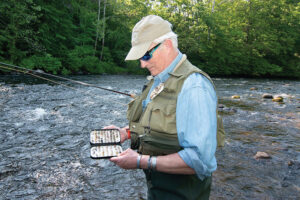
Angler Steve Lewis searches his fly.
Final Notes
- Go slow on East River Road, it narrows to a single lane in spots.
- Growing numbers of black bears exist in rural Connecticut. Although I’ve never heard of one interacting with an angler, if you wander the river in low light, it’s not a bad idea to carry bear spray.
- During the winter, bring towels and a change of clothes in the car in case you take a spill.
- Small amounts of Didymo, often called “rock snot,” exist. If you wade into it, upon getting home kill it by placing your boots in the freezer for 24 hours.
If you witness poaching, call the poaching hotline at 1-800-842-HELP (4357).
Ed Mitchell is the author of four books about fly-fishing and has written for many magazines. He has over forty years of experience in both fresh and saltwater fly-fishing. The author thanks veteran Farmington River guide Bruce Marino for his help with the hatches.
Resources
Upcountry Sportfishing
352 Main Street, New Hartford, CT
860-379-1952, Facebook and Instagram
Gear, great selection of flies, guides, classes, and invaluable advice
Legends on the Farmington River sports lodge
20 River Road, Barkhamsted, CT
860-485-4604, legendsbnb.com
Austin Hawes Campground
American Legion State Forest
198 West River Road, Barkhamsted, CT
860-379-0922, reserveamerica.com

